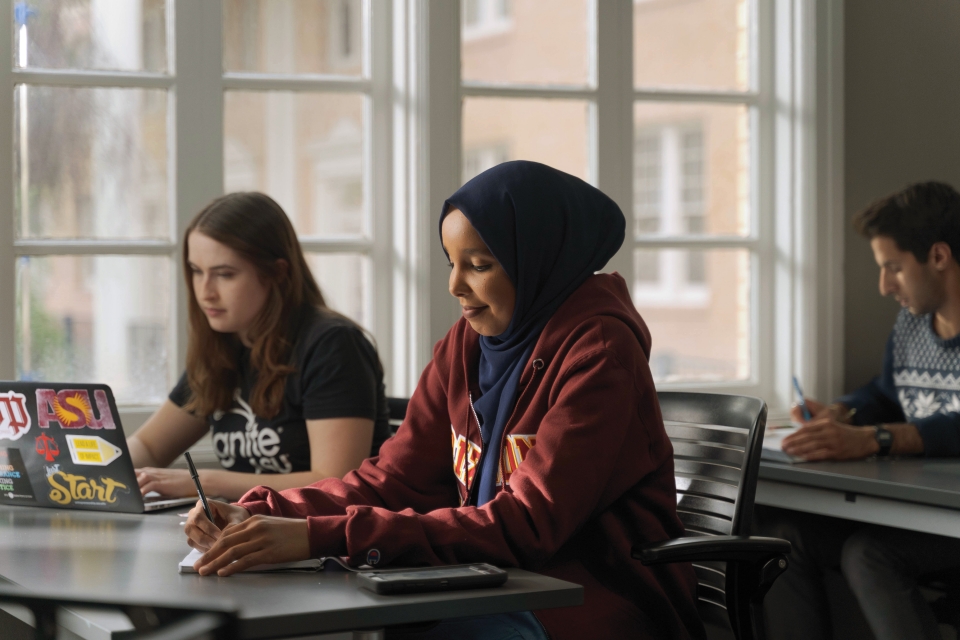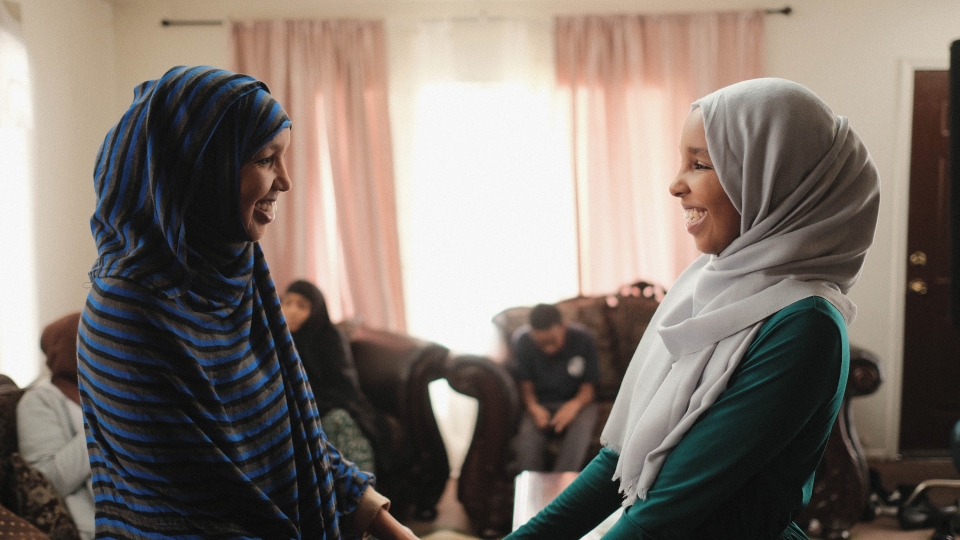Naruro Hassan took a seat among 10 other undergraduate research fellows in John Carlson’s “Inquiry into Religion and Conflict” course one sweltering morning in August 2017, a student like all others who qualified for the program, but also a student unlike any other in class. Carlson, interim director of Arizona State University’s Center for the Study of Religion and Conflict, recalls Hassan’s colorful hijab, bright red lipstick and Converse sneakers peeking out from the rim of her floor-length skirt. Maria Dooling, one of the fellows, remembers her booming voice, commanding attention.
“When she speaks, everyone really listens,” said Dooling, who is graduating in December with degrees in biochemistry and political science. “It’s like she was born to lead.”
Hassan (pictured above, left) is a refugee with an extraordinary story of survival, resilience and rediscovery that began in war-torn Somalia and, after long, trying chapters in a remote refugee camp in Kenya, is unfolding at ASU, where her academic pursuits are as ambitious as the goal she has set for herself. She is majoring in history, minoring in philosophy and African studies, and has pursued certificates in religion and conflict and in political thought and leadership, with eyes on becoming a human rights lawyer. As a student researcher, she assisted Carlson with his justice book project and is working with ASU Professor Keon McGuire on his research project, “The Lived Experiences of Black Muslim Students Attending Predominantly White Institutions.”
Drawing from her refugee experiences, Hassan also works with the Humanitarian African Relief Organization, one of the largest groups aiding refugees and displaced people in Africa.
“You dream about who you want to be, what you want to do, but you don’t know if any of it is possible,” she said about life at the refugee camp in Kenya. “You wonder, ‘Is this opportunity ever going to be available to me? Am I ever going to leave this place?’
“There were a lot of other kids at camp who were smarter than me, who wanted to change the world for the better, but who didn’t have this opportunity. I have this opportunity. Now I have to honor my blessings. I want to be the voice for people who are marginalized, for the people who are left behind.”

Naruro Hassan (right) and Maria Dooling take notes during their religion and conflict class at ASU. “When she speaks, everyone really listens,” Dooling says of Hassan. “It’s like she was born to lead.” Photo by Houseblend
Hassan was 16 when she arrived in Phoenix on June 11, 2014, 11 years after she was separated from her parents and older sister and brother during their desperate escape from the Somali capital of Mogadishu. She had no idea where they were or even if they were alive. “I just kept hoping that I would see them someday,” she said.
The Somali Civil War erupted when Mohammed Siad Barre, a dictator who had ruled the Somali Democratic Republic for 22 years, was forced to flee in 1991 after rival militia groups took control of Mogadishu and unleashed a deadly and destructive struggle for power. A 2017 report by the United Nations High Commission for Refugees indicates that more than 2 million people have been displaced by the bloody conflict, including about 800,000 living as refugees in Kenya, Yemen and Ethiopia.
According to the Centers for Disease Control and Prevention, some 47,000 Somalis came to the U.S. as refugees between 2010 and 2016. Hassan, now 21, is one of them. Her family witnessed the horrors befalling their neighbors and sensed the violence creeping closer to them. That, Hassan says, is why they escaped. In the chaos, she became disconnected from her family. She was 5 and ended up accompanying friends on the arduous journey to the Kakuma Refugee Camp in the impoverished northwest corner of Kenya, near the country’s borders with Uganda, South Sudan and Ethiopia. She spent the next 10 years there.
Kakuma was established in 1992 to house the young refugees known as the “Lost Boys of Sudan.” By the time Hassan arrived, it was home to more than 100,000 refugees and asylum seekers from Sudan, Ethiopia and Somalia. She says the camp represented “immense human suffering ... always dusty, always hot.” There were no paved roads, no hospitals and no buildings other than houses made of mud, and hours-long waits for food that often wasn’t enough for everyone.
What Hassan had was a sense of gratitude for being alive. She cobbled together a family of sorts from the friends she had accompanied to Kakuma and the children she met there, savoring little things like playing soccer with friends and eating together. At school, she learned English and Swahili, Kenya’s lingua franca, and also math and science, even though there were no books. She discovered her passion and skill for debate at Kakuma, while discussing with other young refugees the messy politics of their home countries.
She longed for a bigger platform to learn and share her experiences as a refugee, even though she knew that the odds of leaving the camp were stacked against her. But the experience galvanized her.
“I was somebody who didn’t have a country,” Hassan said, “and I thought, ‘I’m not going to be dehumanized again. I have to fight back.’”
Then she caught the luckiest of breaks.

Naruro Hassan (right), greets her mother, Zahara Omar. They were reunited in 2014, 11 years after violence in Somalia separated the family. Photos by Houseblend
Her mother, Zahara Omar, who had by then been resettled in Phoenix and become a U.S. citizen, never stopped searching for Naruro. She finally found her youngest child after traveling to Kenya and sponsored her to come to Arizona. Naruro joined her sister, Nafiso, a nurse, and her brother, Mohamed, who is studying computer engineering at ASU, in the apartment the family shares in northeast Phoenix.
Hassan enrolled at Camelback High School as a junior and found herself educating classmates who seemed to know little about where she had come from — “Is Africa a country?” one of them asked — while learning new things from new people she met, including one of her best friends, who was born in Mexico. She also became aware that her skin color and religion not only set her apart, but also made her a target.
“In the U.S., I have so many identities in me that are marginalized,” Hassan said. “Being black is marginalized here. Being Muslim is marginalized. Being a woman, a refugee. I’m someone that shouldn’t be here, who doesn’t belong.”
RELATED: Education for Humanity takes leadership role in refugee education
Hassan credits her opportunities at ASU with broadening her perspectives and shaping her activism.
“She’s someone who has lived a very unique set of experiences and can articulate in very concrete terms that these are not an abstraction, that this is what it means to live in a war-ravaged country, this is what it means to be separated from your family because whole populations have been forced out of your country and into refugee camps,” Carlson said.
Hassan is a co-founder and vice president of the Somali Student Association at ASU and the outreach director for Voices of Empathy, a student-led group that she helped start to advocate for the rights of immigrants, women and workers. Through a series of speaking engagements and internships — she has taught English and computer classes to refugees, organized voter registration drives and spoken at Ignite, a TED-style event on campus — Hassan has crystalized her role as an agent of change.
“I’m going to fight for refugees and I’m also going to fight for black people, for Native Americans, for Mexicans, Latinos,” she said. “Because we’re all interconnected. Our freedom, our justice, it’s all interconnected. I can’t be selfish. We have to look out for each other.”
Written by Fernanda Santos, who joined ASU’s Cronkite School of Journalism and Mass Communication after 12 years at The New York Times. This story originally appeared in the fall 2019 issue of ASU Thrive magazine.
Top photo: Naruro Hassan (left) with her sister, Nafiso (right), and their friend, Hafsa Omar, at Papago Park in Tempe. Photo by Houseblend
More Law, journalism and politics

Arizona secretary of state encourages students to vote
Arizona Secretary of State Adrian Fontes looked right and left, taking in the more than 100 students who gathered to hear him speak in room 103 of Wilson Hall.He then told the students in the Intro…

Peace advocate Bernice A. King to speak at ASU in October
Bernice A. King is committed to creating a more peaceful, just and humane world through nonviolent social change.“We cannot afford as normal the presence of injustice, inhumanity and violence,…

CNN’s Wolf Blitzer to receive 41st Walter Cronkite Award for Excellence in Journalism
Wolf Blitzer, the longtime CNN journalist and anchor of “The Situation Room With Wolf Blitzer,” will accept the 41st Walter Cronkite Award for Excellence in Journalism, Arizona State University has…
